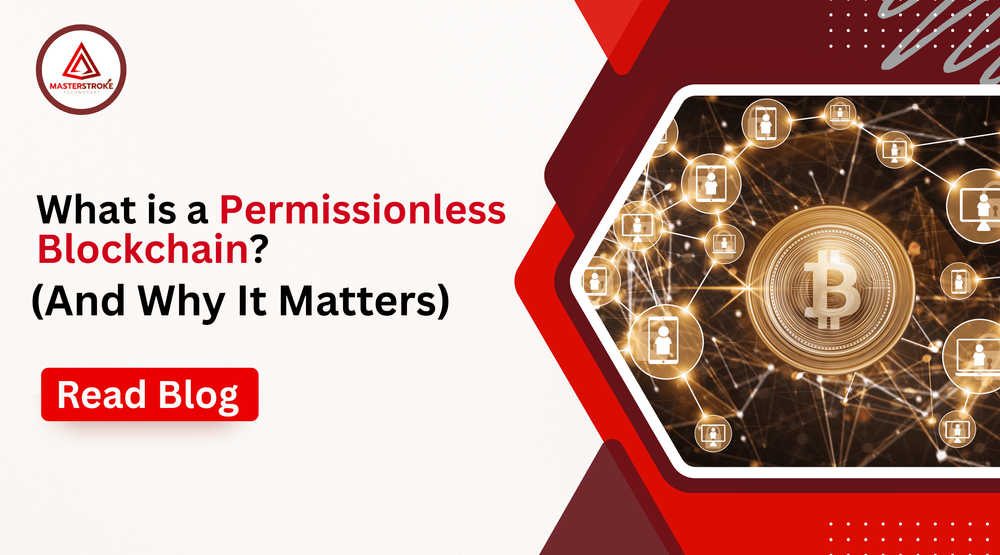What is a Permissionless Blockchain? (And Why It Matters)
 Masterstroke Technosoft
Masterstroke Technosoft
We live in a time when it's hard to know who or what to trust online. With so much happening behind screens, most of us just want to know that the information we're seeing or the money we're sending is safe. That’s where permissionless blockchains come in — a type of technology built not around control, but around openness, transparency, and shared trust.
You might have heard the term tossed around in tech circles or finance forums, but what does it actually mean? And why should it matter to anyone outside of the software labs and cryptocurrency communities?
The Basics: What is a Blockchain?
A blockchain is like a record book — digital, of course — where every transaction, contract, or agreement is stored on a shared network. Every entry is recorded in a block, and each block is linked to the one before it. That makes it nearly impossible to change anything without everyone noticing. It's a permanent ledger, open for verification.
Now, What Makes It “Permissionless”?
In a permissioned blockchain, only certain people are allowed to write entries in that record book. It’s controlled, like a private meeting where only those with an invitation can speak.
But a permissionless blockchain is different.
In a permissionless system, anyone can join, participate, and validate information. There’s no gatekeeper. It’s like an open town square where anyone can come forward with facts, and once enough people agree, that fact is added to the record.
Think Bitcoin or Ethereum. No central authority tells you if you can be a part of it. You just join.
Why This Matters
At first glance, this might not seem revolutionary. But think deeper.
A permissionless blockchain doesn’t ask for permission. That means it doesn’t rely on trust in a company, a government, or a person. It relies on math, consensus, and transparency.
1. Censorship Resistance
No one can stop you from using a permissionless blockchain. This is powerful in places where financial systems are controlled tightly, or where access to global markets is restricted. It offers a route to freedom — not just financial, but informational.
2. Open Innovation
When there’s no barrier to entry, anyone can build. Developers from anywhere can create tools, apps, and solutions on top of these blockchains. This openness has led to an explosion in innovation, especially in decentralized finance (DeFi) and non-fungible tokens (NFTs).
3. Stronger Security
Since anyone can participate, these systems often have more people checking and verifying transactions. That collective oversight makes it harder for bad actors to cheat the system. It's the wisdom of the crowd, turned into code.
4. True Ownership
In traditional platforms, you own your data or money only as long as the provider allows it. With a permissionless blockchain, control sits with the user. If you own a token or NFT, it’s yours — not stored on someone else's server that could be shut down or seized.
Why Should Businesses Care?
Companies often look at blockchain as a buzzword. But permissionless blockchains aren’t just for cryptocurrencies or tech enthusiasts. They represent a shift in how we store truth, ownership, and agreements.
Imagine a supply chain where every product’s journey is traceable by anyone. Or a hiring system where credentials are verified on a shared ledger, impossible to fake. Or payments made across continents in seconds without middlemen.
These aren't future fantasies — they’re happening today.
The MST Blockchain Perspective
At MST Blockchain, we believe that open systems foster stronger ecosystems. Our vision aligns with permissionless technology because it aligns with real people — builders, users, dreamers — who want fair access and a shared playing field.
Our work centers on ensuring that permissionless platforms aren’t just secure, but usable and scalable. Because technology only changes lives when it can be used easily and effectively.
The Challenges
This isn’t a one-sided story. Permissionless systems do come with questions.
- Scalability: More users mean more data, and not every blockchain handles that well yet.
- Energy Usage: Some early blockchains, like Bitcoin, require significant electricity to maintain.
- Bad Actors: With open access, the door is also open to those who want to exploit it. Fraud still exists, just as it does in any system.
But the industry is evolving. New consensus models are being built to reduce energy use. Layer 2 technologies are emerging to handle scalability. Communities are setting standards for better security and accountability.
Real-World Examples
- Financial Access in Africa: Platforms built on Ethereum are being used in parts of Africa where banks are few but mobile phones are common. People can now save, borrow, and earn using blockchain-based systems — without needing a bank account.
- Art and Identity: Artists are sharing their work directly through NFTs. Not through galleries or intermediaries. Their ownership is clear, and their income flows directly to them
- Supply Chain Transparency: From coffee beans to diamonds, products can now carry digital footprints that prove their journey. This isn’t just good for consumers — it builds trust.
Final Thoughts
Permissionless blockchains represent more than just technology. They offer a quiet rebellion against centralized control, and a push towards systems where fairness is built into the code.
At MST Blockchain, we see this not just as innovation, but as a movement. A way to return power to individuals, and invite everyone to take part in shaping the future.